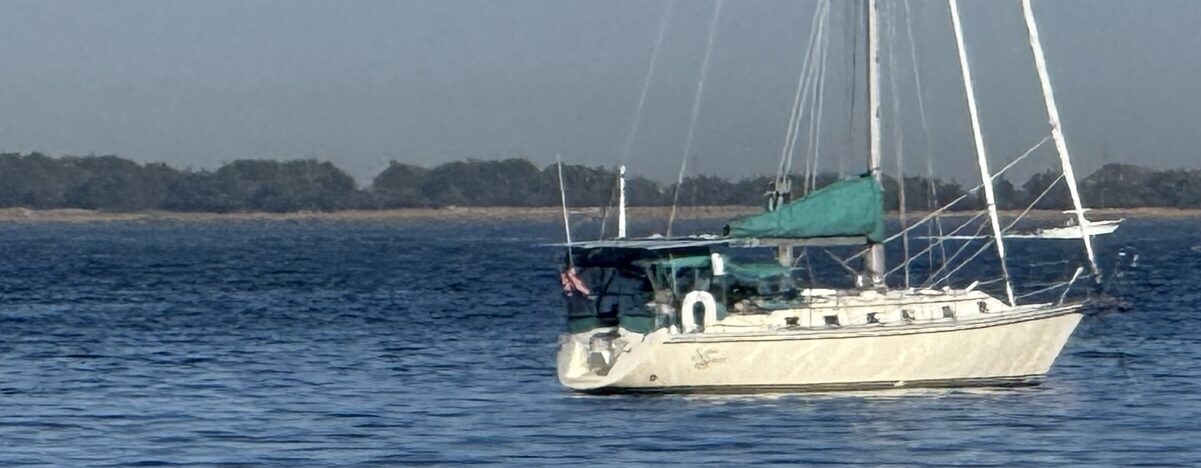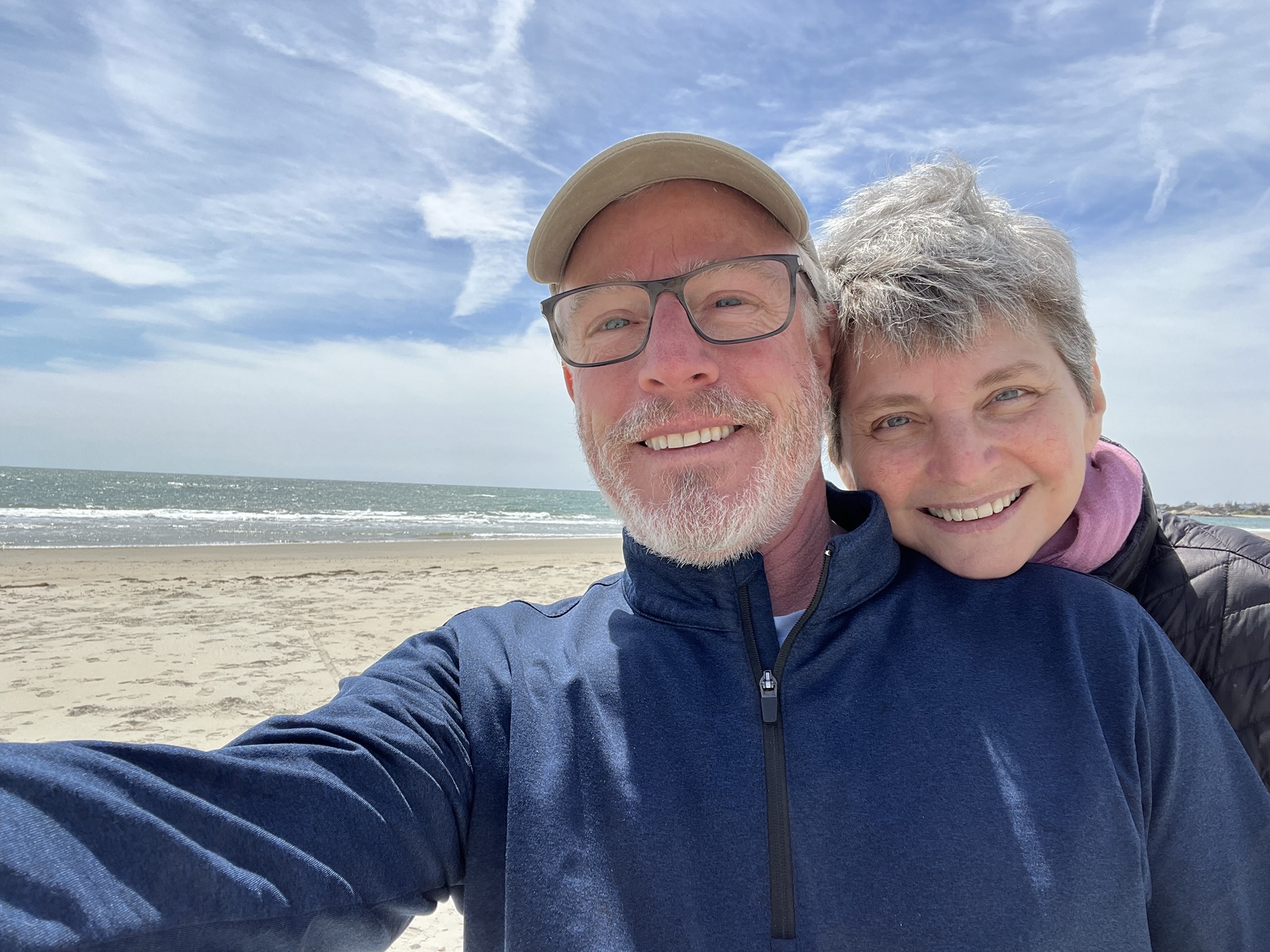Skip to content

Living on a boat leads me to focus on the weather and environment like never before. As our world is warming, due to the amount of carbon we pump into the air, the number and intensity of storms in the Atlantic is rising. I began following Elsa, the fifth named storm of 2021, as soon as she was named and it looked like she’d grow into something major. I use NOAA’s Hurricane Tracker app as my early warning system. By last Monday, it appeared she’d hit Florida as a hurricane, track along the Atlantic coast, and perhaps give us tropical storm conditions in New England. Luckily, Elsa didn’t stay a hurricane long and Florida was spared a major problem.
I began to ready the boat and myself for Elsa on Thursday. By then we knew the timing would be that the storm would build in the area Friday morning and be gone by about mid-afternoon. To prepare, I added an additional fender between Sans Souci and the dock and doubled up my dock lines. In a tropical storm, rotating counter-clockwise in the northern hemisphere, the wind will come from from several directions as the center moves past. I wanted to be ready to fend off being blown into the dock and also be safe when blown away from it. My two headsails were already tightly furled so I just rolled them a few additional times to wrap the sheets more tightly and then I took the spinnaker and spare halyards and wrapped them around the length of the furled sails. I added additional lines wrapped around the mainsail to keep the sail cover firmly in place. The winds were not forecasted to gust above 40 knots in Fall River so I opted to leave the bimini and dodger up; I just secured all of the clear vinyl side panels and made sure everything was zipped and snapped in place.
Friday morning, as the storm approached, I turned on all of my instrumentation so I could better track the storm and also get a feel for how I might predict an approaching storm if I was at sea. I had a high wind alarm set to warn if winds rose to over 30 knots.
The most notable feature of this storm was the rain- there was lots of it. Over 2 inches of rain fell in the few hours it took Elsa to move through. Initially, the wind was easterly and that put us to leeward of land and some condos overlooking the marina. Being somewhat protected in the lee was good since the storm ended up passing slightly west of us, putting us on the windier side of Elsa.

As the eye passed over, the wind diminished to near calm. The photo above is of the barometer, taken as the pressure flattened out, indicating the passing of the center of the storm. Not long after, the winds switched to westerly and increased. We saw gusts over 30 knots and building waves on the bay with our position no longer in the lee of anything protective.
I filmed the video above to explain what I was seeing on my instruments during a windier part of the storm. By about 3 PM, Elsa had moved on up the coast and was making life difficult for Mainers, leaving sunny skies over us.


Wind over time
The pressure profile in the picture above is characteristic of a fast moving, deep low. it seemed to bottom out at about 29.50 inches of mercury, making this a strong storm, but definitely far from anything catastrophic. It would have been uncomfortable and somewhat dangerous to ride out at sea but posed no problems to us safely tucked in at the dock.
Friday evening I enjoyed a lovely dinner with my dock neighbors, Mark and Sue on their Nordhavn 50. I greatly appreciate how generous and friendly boaters are to each other. There is camaraderie, even between sailors and power boaters as we all face similar challenges and rewards of spending time on the sea.
Like this:
Like Loading...
{"id":null,"mode":"button","open_style":"in_modal","currency_code":"USD","currency_symbol":"$","currency_type":"decimal","blank_flag_url":"https:\/\/www.gilpatric.me\/wp-content\/plugins\/tip-jar-wp\/\/assets\/images\/flags\/blank.gif","flag_sprite_url":"https:\/\/www.gilpatric.me\/wp-content\/plugins\/tip-jar-wp\/\/assets\/images\/flags\/flags.png","default_amount":1000,"top_media_type":"featured_image","featured_image_url":"https:\/\/www.gilpatric.me\/wp-content\/uploads\/2021\/05\/EFB0789C-BF66-4202-A59D-42885F7080D6-scaled-200x150.jpeg","featured_embed":"","header_media":null,"file_download_attachment_data":null,"recurring_options_enabled":true,"recurring_options":{"never":{"selected":true,"after_output":"One time only"},"weekly":{"selected":false,"after_output":"Every week"},"monthly":{"selected":false,"after_output":"Every month"},"yearly":{"selected":false,"after_output":"Every year"}},"strings":{"current_user_email":"","current_user_name":"","link_text":"Leave a tip","complete_payment_button_error_text":"Check info and try again","payment_verb":"Leave a Tip","payment_request_label":"Sailing Sans Souci","form_has_an_error":"Please check and fix the errors above","general_server_error":"Something isn't working right at the moment. Please try again.","form_title":"Sailing Sans Souci","form_subtitle":null,"currency_search_text":"Country or Currency here","other_payment_option":"Other payment option","manage_payments_button_text":"Manage your payments","thank_you_message":"Thank you, I am very grateful for your support!","payment_confirmation_title":"Sailing Sans Souci","receipt_title":"Your Receipt","print_receipt":"Print Receipt","email_receipt":"Email Receipt","email_receipt_sending":"Sending receipt...","email_receipt_success":"Email receipt successfully sent","email_receipt_failed":"Email receipt failed to send. Please try again.","receipt_payee":"Paid to","receipt_statement_descriptor":"This will show up on your statement as","receipt_date":"Date","receipt_transaction_id":"Transaction ID","receipt_transaction_amount":"Amount","refund_payer":"Refund from","login":"Log in to manage your payments","manage_payments":"Manage Payments","transactions_title":"Your Transactions","transaction_title":"Transaction Receipt","transaction_period":"Plan Period","arrangements_title":"Your Plans","arrangement_title":"Manage Plan","arrangement_details":"Plan Details","arrangement_id_title":"Plan ID","arrangement_payment_method_title":"Payment Method","arrangement_amount_title":"Plan Amount","arrangement_renewal_title":"Next renewal date","arrangement_action_cancel":"Cancel Plan","arrangement_action_cant_cancel":"Cancelling is currently not available.","arrangement_action_cancel_double":"Are you sure you'd like to cancel?","arrangement_cancelling":"Cancelling Plan...","arrangement_cancelled":"Plan Cancelled","arrangement_failed_to_cancel":"Failed to cancel plan","back_to_plans":"\u2190 Back to Plans","update_payment_method_verb":"Update","sca_auth_description":"Your have a pending renewal payment which requires authorization.","sca_auth_verb":"Authorize renewal payment","sca_authing_verb":"Authorizing payment","sca_authed_verb":"Payment successfully authorized!","sca_auth_failed":"Unable to authorize! Please try again.","login_button_text":"Log in","login_form_has_an_error":"Please check and fix the errors above","uppercase_search":"Search","lowercase_search":"search","uppercase_page":"Page","lowercase_page":"page","uppercase_items":"Items","lowercase_items":"items","uppercase_per":"Per","lowercase_per":"per","uppercase_of":"Of","lowercase_of":"of","back":"Back to plans","zip_code_placeholder":"Zip\/Postal Code","download_file_button_text":"Download File","input_field_instructions":{"tip_amount":{"placeholder_text":"How much would you like to tip?","initial":{"instruction_type":"normal","instruction_message":"How much would you like to tip? Choose any currency."},"empty":{"instruction_type":"error","instruction_message":"How much would you like to tip? Choose any currency."},"invalid_curency":{"instruction_type":"error","instruction_message":"Please choose a valid currency."}},"recurring":{"placeholder_text":"Recurring","initial":{"instruction_type":"normal","instruction_message":"How often would you like to give this?"},"success":{"instruction_type":"success","instruction_message":"How often would you like to give this?"},"empty":{"instruction_type":"error","instruction_message":"How often would you like to give this?"}},"name":{"placeholder_text":"Name on Credit Card","initial":{"instruction_type":"normal","instruction_message":"Enter the name on your card."},"success":{"instruction_type":"success","instruction_message":"Enter the name on your card."},"empty":{"instruction_type":"error","instruction_message":"Please enter the name on your card."}},"privacy_policy":{"terms_title":"Terms and conditions","terms_body":null,"terms_show_text":"View Terms","terms_hide_text":"Hide Terms","initial":{"instruction_type":"normal","instruction_message":"I agree to the terms."},"unchecked":{"instruction_type":"error","instruction_message":"Please agree to the terms."},"checked":{"instruction_type":"success","instruction_message":"I agree to the terms."}},"email":{"placeholder_text":"Your email address","initial":{"instruction_type":"normal","instruction_message":"Enter your email address"},"success":{"instruction_type":"success","instruction_message":"Enter your email address"},"blank":{"instruction_type":"error","instruction_message":"Enter your email address"},"not_an_email_address":{"instruction_type":"error","instruction_message":"Make sure you have entered a valid email address"}},"note_with_tip":{"placeholder_text":"Your note here...","initial":{"instruction_type":"normal","instruction_message":"Attach a note to your tip (optional)"},"empty":{"instruction_type":"normal","instruction_message":"Attach a note to your tip (optional)"},"not_empty_initial":{"instruction_type":"normal","instruction_message":"Attach a note to your tip (optional)"},"saving":{"instruction_type":"normal","instruction_message":"Saving note..."},"success":{"instruction_type":"success","instruction_message":"Note successfully saved!"},"error":{"instruction_type":"error","instruction_message":"Unable to save note note at this time. Please try again."}},"email_for_login_code":{"placeholder_text":"Your email address","initial":{"instruction_type":"normal","instruction_message":"Enter your email to log in."},"success":{"instruction_type":"success","instruction_message":"Enter your email to log in."},"blank":{"instruction_type":"error","instruction_message":"Enter your email to log in."},"empty":{"instruction_type":"error","instruction_message":"Enter your email to log in."}},"login_code":{"initial":{"instruction_type":"normal","instruction_message":"Check your email and enter the login code."},"success":{"instruction_type":"success","instruction_message":"Check your email and enter the login code."},"blank":{"instruction_type":"error","instruction_message":"Check your email and enter the login code."},"empty":{"instruction_type":"error","instruction_message":"Check your email and enter the login code."}},"stripe_all_in_one":{"initial":{"instruction_type":"normal","instruction_message":"Enter your credit card details here."},"empty":{"instruction_type":"error","instruction_message":"Enter your credit card details here."},"success":{"instruction_type":"normal","instruction_message":"Enter your credit card details here."},"invalid_number":{"instruction_type":"error","instruction_message":"The card number is not a valid credit card number."},"invalid_expiry_month":{"instruction_type":"error","instruction_message":"The card's expiration month is invalid."},"invalid_expiry_year":{"instruction_type":"error","instruction_message":"The card's expiration year is invalid."},"invalid_cvc":{"instruction_type":"error","instruction_message":"The card's security code is invalid."},"incorrect_number":{"instruction_type":"error","instruction_message":"The card number is incorrect."},"incomplete_number":{"instruction_type":"error","instruction_message":"The card number is incomplete."},"incomplete_cvc":{"instruction_type":"error","instruction_message":"The card's security code is incomplete."},"incomplete_expiry":{"instruction_type":"error","instruction_message":"The card's expiration date is incomplete."},"incomplete_zip":{"instruction_type":"error","instruction_message":"The card's zip code is incomplete."},"expired_card":{"instruction_type":"error","instruction_message":"The card has expired."},"incorrect_cvc":{"instruction_type":"error","instruction_message":"The card's security code is incorrect."},"incorrect_zip":{"instruction_type":"error","instruction_message":"The card's zip code failed validation."},"invalid_expiry_year_past":{"instruction_type":"error","instruction_message":"The card's expiration year is in the past"},"card_declined":{"instruction_type":"error","instruction_message":"The card was declined."},"missing":{"instruction_type":"error","instruction_message":"There is no card on a customer that is being charged."},"processing_error":{"instruction_type":"error","instruction_message":"An error occurred while processing the card."},"invalid_request_error":{"instruction_type":"error","instruction_message":"Unable to process this payment, please try again or use alternative method."},"invalid_sofort_country":{"instruction_type":"error","instruction_message":"The billing country is not accepted by SOFORT. Please try another country."}}}},"fetched_oembed_html":false}
{"date_format":"F j, Y","time_format":"g:i a","wordpress_permalink_only":"https:\/\/www.gilpatric.me\/2021\/07\/11\/elsa\/?replytocom=39","all_default_visual_states":"inherit","modal_visual_state":false,"user_is_logged_in":false,"stripe_api_key":"pk_live_51IvgnEGjPDiZWIJPQEKXsmJozbao78jDHLpn9tASSfGggYticnBzGfckcqfsCKX8Xhy8QjaVWauissn0jTXTyrjH00Udifg8oh","stripe_account_country_code":"US","setup_link":"https:\/\/www.gilpatric.me\/wp-admin\/admin.php?page=tip-jar-wp&mpwpadmin1=welcome&mpwpadmin_lightbox=do_wizard_health_check","close_button_url":"https:\/\/www.gilpatric.me\/wp-content\/plugins\/tip-jar-wp\/\/assets\/images\/closebtn.png"}









Did you consider leaving the Bimini unzipped so the wind could go through instead of putting pressure on it?
I did, but the zippers are all so fragile that I was afraid I’d have trouble getting it back together. The canvas is something I need to deal with before too long. I can’t have it so I can’t take all that down when I’m at sea. It didn’t present a problem with Elsa, however.